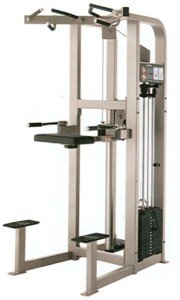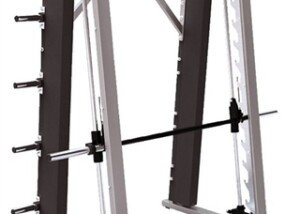
Seeking a pull-up substitution if you are obese or overweight?
There are several substitutes for pull-ups that overweight or clinically obese exercise enthusiasts can perform.
Keep in mind that doing an actual pull-up is NOT a natural ability for even a thinner person — the ability to do pull-ups is an acquired ability, though sometimes, fit, thin people can naturally crank out a few. Rock climbers develop this ability just from climbing.
If you’re overweight or obese and belong to a health club or gym, see if the gym has what’s called a pull-up assist machine.

Pull-up assist equipment
These machines subtract weight from your body weight, so that, if you weigh 200 pounds, these machines can be set to make you “weigh” half that much or less.
Any overweight or obese exerciser can use a pull-up assist machine, and this tool is a perfect substitute.
Place the pin, say, at the 120-pound mark in the weight stack. This will subtract 120 pounds from your body weight.
Stand on the foot steps and grab the handles above your head. Then lift a knee on the rest pad in front of yourself, then get the other knee on it.
This may sound confusing to read, but once you are standing before one of these machines, you’ll probably know instantly how it works, especially after you’ve seen others use it.
The machine will mimic for you a pull-up motion, yet you’ll feel 120 pounds lighter.
Experiment with different weight “assists” by sticking the pin in different places.
The next substitute for pull-ups for overweight or obese exercisers is the modified version.
Find the gym’s Smith machine. This is also known as tracked barbell squat equipment.
Place the bar 3-4 feet from the floor. Get beneath it and place hands on it and hang straight-armed.
You can now place your feet at various points along the floor, relative to the bar.
The further your feet are out, the more challenging the exercise will be. Your legs can be straight or bent, but keep them together.
From this straight-arm hang, hoist yourself up, but of course, your feet remain on the floor.
If this wasn’t too hard, see if you can do 10. If that wasn’t too difficult, increase the pull-resistance by moving your feet further out on the floor away from the bar.
If this still isn’t too hard, then lower the bar one foot.
The lower the bar, the closer you can bring your body towards a horizontal position if your feet are all the way out.
Though a traditional pull-up is done when the body hangs vertically, you can mimic the exercise by being almost horizontal, heels on floor, legs straight and in alignment with upper body.
The lower the bar, the more challenging this exercise is.
The third substitute for pull-ups that overweight and obese people can do is the standard lat pull-down maneuver, and you can use various handles.
This exercise is very similar to a pull-up and thus qualifies for a substitute, and overweight and obese exercisers are on an even playing field with any thinner person, when it comes to the lat pull-down exercise. This will strengthen your body for pull-ups.
 Lorra Garrick is a former personal trainer certified through the American Council on Exercise. At Bally Total Fitness she trained women and men of all ages for fat loss, muscle building, fitness and improved health.
Lorra Garrick is a former personal trainer certified through the American Council on Exercise. At Bally Total Fitness she trained women and men of all ages for fat loss, muscle building, fitness and improved health.
.


























